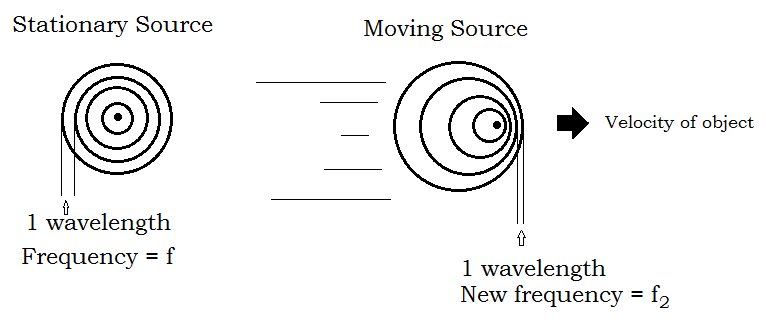
As the wavelength decreases, the frequency must increase. This means that motion cannot affect the speed, but only the wavelength and the frequency. (Remember, all light waves travel at the speed of light through empty space, no matter what. To observer A, the waves seem to follow one another more closely, at a decreased wavelength and thus increased frequency.

The source is seen in four positions, S 1, S 2, S 3, and S 4, each corresponding to the emission of one wave crest. In part (b), we show the situation from the perspective of three observers. From the point of view of observer A, this motion of the source has decreased the distance between crests-it’s squeezing the crests together, this observer might say. Between the time one crest is emitted and the next one is ready to come out, the source has moved a bit, toward the bottom of the page. On the other hand, if the source of light is moving with respect to the observer, as seen in part (b), the situation is more complicated. Observers located anywhere else would see the same thing. The observer, who happens to be located in the direction of the bottom of the image, sees the light waves coming nice and evenly, one wavelength apart. The crests are separated by a distance, λ, where λ is the wavelength. The light waves spread out evenly in all directions, like the ripples from a splash in a pond.
#Doppler effect astronomy series#
The source gives off a series of waves, whose crests we have labeled 1, 2, 3, and 4. The Doppler effect works at all wavelengths of the electromagnetic spectrum. This article explains how it can tell us about solar oscillations, the rotation of the Milky Way, the expansion of the Universe and much more. The observed spectra of objects moving through space toward Earth are shifted toward the blue (shorter wavelengths), while objects moving through space away from Earth are shifted toward the red. The Doppler effect in astronomy Robert Lambourne Open University, Milton Keynes, UK Most of our knowledge of the properties of stars and galaxies has been obtained using the Doppler effect. In part (a) of the figure, the light source (S) is at rest with respect to the observer. The Doppler effect is very important to both optical and radio astronomy.

Observer B, whose line of sight is perpendicular to the source’s motion, sees no change in the waves (and feels left out). Observer C sees the waves stretched out by the motion and sees a redshift. Observer A sees waves compressed by this motion and sees a blueshift (if the waves are light). Wave crest 1 was emitted when the source was at position S1, crest 2 at position S2, and so forth. (b) The source S now moves toward observer A and away from observer C.

(a) A source, S, makes waves whose numbered crests (1, 2, 3, and 4) wash over a stationary observer. The general principle, now known as the Doppler effect, is illustrated in Figure 5.22. He then applied what he learned to all waves, including light, and pointed out that if a light source is approaching or receding from the observer, the light waves will be, respectively, crowded more closely together or spread out. In 1842, Christian Doppler first measured the effect of motion on waves by hiring a group of musicians to play on an open railroad car as it was moving along the track.


 0 kommentar(er)
0 kommentar(er)
